|
As the home stretch of the school year comes into view, make sure to keep some fun reading material in your routine. Books of good pictures, fascinating slices of historical life, and hefty concepts made simple feature in this edition of Endpapers. Enjoy!
Books Made Mostly of Pictures I’ve praised Peter Spier before and I’ll gladly do it again. Rain and Fast-Slow High-Low both promise many re-“reads” – quite a feat for a set of word-less picture books! Rain tells the visual story of a rainy day, from its sudden onslaught, to its splashy pleasures, to the glistening and drippy aftermath. Fast-Slow High-Low is an illustrated feast. Each page explores a pair of opposites with a collection of drawings. My four-year-old has enjoyed this book many days in a row and never tires of the details. Mice feature frequently as fictional adventure heroes and this German collection by Torben Kulhmann is yet another mouse-hero tale. We enjoyed Lindburgh and Edison, each of which tells the story of a scientifically-minded mouse and his brave explorations. Beautiful illustrations (a non-negotiable for me) pair with short chapters to make for a picture book with a sense of maturity. The series also includes Armstrong and Einstein. Sophie Blackall is a personal favorite illustrator. Her Finding Winnie and Hello Lighthouse aren’t even two of my kids’ favorite books; they’re just two of my own favorites. I was delighted to find that Blackall’s brand-new picture book, Farmhouse, did not disappoint. Based on research of a real farmhouse, the book imagines what the historical family who owned the home was like: their hopes, dreams, joys, sorrows, ups, downs, and all the experiences in between. Reminding us that all of life sifts down through the generations in scraps and pieces, the story still honors the significance of those untold ordinary moments. It’s beautifully done. Highly recommended. Journey by Aaron Becker tells a story without words. In drawings of simple elegance, a lonely afternoon gives way to a magical world, a valiant mission, and a new friend. This sweet word-less book (yes, another one!) is suitable for littles to enjoy alone, or perfect for families to explore together. If you love it, find the sequel, Quest! Books Made Mostly of Fascinating Information The story of American immigration is often handled from the western edge of the Atlantic, the Ellis Island edge. Black Potatoes by Susan Campbell Bartoletti looks at immigration, at least the Irish immigration, from the other side. From the first arrival of the potato blight through the ill-devised aid efforts and the fallout among the Irish people, the book explores mid-nineteenth century Ireland without sparing the gritty details. The book is middle grade nonfiction, an eye-opening read. Highly recommended for middle or high school. Bud & Me by Alta Abernathy is the unbelievable true story of two brothers who crisscrossed the nation alone several times on horseback, motorcycle, and car – all before either of them turned 12 years old. It’s pretty impressive. I won’t say more. You’ll have to read it for yourself. Our family did the audiobook, which was a fun way to experience the story. Books Made of Fascinating Information Told through Pictures Difficult concepts made simple. Millions, Billions, and Trillions and Prices! Prices! Prices! by David Adler and Edward Miller put the ideas of huge numbers and price inflation into words – and pictures – that children can begin to grasp. We spent time with both of these books and they led to good discussion. The author/illustrator team also publish others, mostly math and number-related. Perfect for upper elementary grades.
0 Comments
Chestnuts roasting by an open fire.
Jack Frost nipping at your nose. Yuletide carols being sung by a choir, And in your lap, a book of prose. If this is your vision for Christmas break, read on! Old Stories for New Readers If Christmas is evoked for you by old-fashioned Christmas cityscapes and church pageants, Great Joy by Kate DiCamillo will strike a chord. Gentle-spirited Frances notices a homeless street performer as the cold of December inches toward Christmas. Her mother is far more focused on Frances’s costume for the upcoming pageant. Will the girl find a way to share the good news of great joy with the humble stranger? Eugene Field’s Wynken, Blynken and Nod might not be a Christmas poem, but it contains the essence of Christmas coziness. Publishers like to make a quick buck on classic poems, especially squeezed into anthologies, so you may find ten versions or more at your local library. The poem alone is lovely, but this edition with illustrations by Johanna Westerman is certainly the best picture version. For a bedtime story during the winter months, this one would be delightful. The immortalized Christmas Truce of 1914 is captured in Shooting at the Stars by John Hendrix. Presented in the form of a letter home from the front, the book features richly colored illustrations that capture this unlikely Christmas Eve celebration. The story is told with tenderness and joy, while hinting at the harsh reality into which this fairy-tale event is nestled. New Stories for Any Readers A Very Mercy Christmas by the author/illustrator team of Kate DiCamillo and Chris Van Dusen is the latest in my favorite pig-themed series. Ever wary of new spins on Christmas, I was grateful to see that this hot-off-the-press book sticks to the classic traditions of Christmas-lovers (plus, of course, toast). Admittedly, it’s not a profound story, but if Mercy Watson and her human friends are friends of yours, you’ll enjoy this Christmas book. Winterhouse by Ben Guterson similarly impressed me with its wholesomeness. While the gospel message is not present, the story is set at Christmastime and delivers a black-and-white view of good versus evil. Magic, puzzles and codes, dark strangers, a huge library, and one innocent eleven-year-old girl (yes, she’s an orphan) collide in a lavish mansion hotel on Lake Luna over the Christmas holidays. The story seems designed for fans of Harry Potter and The Mysterious Benedict Society, but a variety of classic children’s literature is name-dropped throughout the book. I was truly delighted by this story. Suggested for middle grade and high school. True Stories for Imaginative Readers Snowflake Bentley by Jacqueline Briggs Martin tells the biography of Wilson Bentley, the first person to record snowflakes in photographs. The story, along with the woodcut illustrations, won this book a Caldecott Medal in 1999. It’s a good one to stash away for the first big snowfall. Hinds’ Feet on High Places by Hannah Hurnard might not be technically “factual,” but it’s True in deeper ways. This book was recommended by one of my students and the very next week I stumbled upon this lovely illustrated version at my used bookstore. It’s an allegory and not a veiled one. Much-Afraid begins her journey with the Chief Shepherd in order to escape the Valley where she dwells with her fellow Fearings. Her trip takes her through desert, shores of loneliness, mist, and forests of danger, among other perils, and by her side are always her two gentle guides. (To name them would give too much away, so I won’t.) Consider making time for this book as a family. Looking for more Christmas ideas? Try the Endpapers issues from 2021 and 2020. It’s October. Don’t worry: no Halloween theme here. But I am suggesting a few reads for the bold among you, so please read descriptions before ordering any books.
After doing a deep(ish) dive on the Brooklyn Bridge in our homeschool room this month, I have a few books to suggest on architecture. The next selections are offered with hearty approval, a few for small readers and one for parents. The final set of books in this issue are valuable and appropriate, but only in the right reading context. The two selections geared toward kids are great, but should have parental oversight, and the other book selection is for the well-prepared high-school or adult reader. I hope your reading hours are cozy this month! For the Architecturally Curious Who Built That? Bridges by Didier Cornille is a visually sparse but engaging collection of sketches that show how bridges through the eras have been constructed. Fascinating and accessible for young readers who love seeing how thing work. Also fun – it’s oriented to be opened bottom to top instead of right to left. Draw 50: Buildings and Other Structures is one in a collection by Lee J. Ames. Our family has loved many in this series, and this one is certainly more advanced. For artists interested in buildings, though, it’s an exciting set of structures to practice drawing. Brooklyn Bridge by Lynn Curlee is a perfect balance between a picture book and a research reference. More thorough than Secret Engineer or Twenty-One Elephants, other picture books about the Brooklyn Bridge that we read, but nowhere near the scale of McCullough’s 600+ page The Great Bridge, this hearty storybook with pictures taught our family a lot about the history and construction of the Brooklyn Bridge in just a few sittings. Recommended Without Reservation I’ve heard about the Brambly Hedge series by Jill Barklem for years, but finally checked it out this past month. If you’re a hold-out like me, I recommend starting with The Secret Staircase. Drawings that will keep you staring pair with a sweet and non-threatening mystery tale. This book is like a cozy blanket and a mug of tea. The Boy Who Loved Maps by Kari Allen is a rare gem: a brand-new book that’s perfectly pure without agenda or nods to cultural trends. It’s nothing but a sweet story of friendship between two children, laced together with the imagery of maps, something most kids love. I was impressed to find this pure little story. Check it out from your library so that your librarian knows how much we appreciate this sort of literature! You’ve probably heard of Sally Clarkson. Most homeschooling moms have. The Life-Giving Home was my first dive into her repertoire. She’s a wealth of ideas and information and I was encouraged by reading this book. I admit that I find the sum total of her home-education lifestyle to be a bit pie-in-the-sky, but I loved reading through this book and marking the ideas I want to try out or come back to later. This is worth any homeschool mom’s time. Recommendations… but with caveats Fiery Night by Sally M. Walker is vivid. The Great Chicago Fire is evoked powerfully through the book’s skillful illustrations by Kayla Harren. A mini story of a boy and his pet goat (a story that is actually true!) frames the massive catastrophe in a smaller scale for young readers and listeners. It’s an impressive book and one that would pair well with a short fire safety unit. (National Fire Prevention Week is coming up on October 9th.) I suggest looking through this before sharing with sensitive eyes. From up on Poppy Hill is a movie produced by Studio Ghibli. We watched it, but not with our children, and found it wonderfully endearing. It’s a coming of age story, and does include light romance (not sexualized in any way) so it isn’t quite suited for smaller kids, despite its animation. It’s not just a love story though. It’s about family and grief and responsibility and determination to fight for what’s right. If you think you don’t like anime, this might be the film to change your mind. Try it out as a date night movie for mom and dad first. Klara and the Sun by Kazuo Ishiguro grabbed me on page one and didn’t let me go until I closed the back cover. The setting is futuristic, the imagined end result of a STEM-obsessed culture. Though most of the characters are humans, it’s the artificial intelligence Klara (who functions as narrator) who possesses the most faith, sacrificial love, and understanding. Ishiguro seems to be calling us to hold tightly to faith, love, and hope ourselves before computerized solutions to life's problems snuff them out. Suggested for adults and mature high schoolers. A note on last issue’s recommendation In August, I recommended the Little Britches series to you. I have a confession to make: when I sent that issue, I had not yet read the title book in that series. I had read – and greatly enjoyed – Mary Emma and Company and The Home Ranch, but only after publishing Issue XII did I start reading Little Britches with my children… and realized how much verbal editing it needed as a read-aloud. The rough cowboy language is mild, but not negligible. It crops up every few chapters. I trimmed out the offending words as I read to my own children, but I was glad I had not handed it off to my eight-year-old to read alone. Oh, and the ending isn’t exactly happy. We had some teary eyes here when it was over. The series is standard fare for any homeschooling reading list and I still feel confident offering it, but I would have given some warnings if I’d pre-read it. If you’ve read it, or are reading it, you might love this podcast series which has several episodes on Little Britches. Summer is winding down, with the exception of the heat which seems to be gearing up. A few delightful stories have come my way recently and I’m excited to share this edition of Endpapers. This whole set of books is ideal for late summer reading, so pick one to fill in those poolside hours in this last month of summertime.
Sweet stories for young readers and listeners Christina Katerina and the Box by Patricia Lee Gauch (with illustrations by Doris Burn) is an adorable throwback story to times when a single large box could provide weeks of playtime. Friendship, creativity, and resilience are modeled well in this sweet picture story. Text is brief and rhythmic, just right for young listeners. Warning: it just may encourage you to order something big enough on Amazon Prime to merit a jumbo cardboard box. We Were Tired of Living in a House by Liesel Moak Skorpen is made perfect by its illustrations. Doris Burn, illustrator of Christina Katerina and the Box, brings this beautiful story to life with her pen and ink drawings. A story of sibling affection and adventure, We Were Tired of Living in a House re-imagines every child’s game of “orphans.” Like Christina Katerina, the story is rhythmic and predictable, but in the way that makes you smile with each page turn. I adore this book. [Be careful to find the 1969 printing. The book has been reprinted with new – and very disappointing – illustrations. It is the vintage drawings that complete this book.] The Milly-Molly-Mandy series by Joyce Lankester Brisley follows a little girl through the mildest of trials and struggles. In classic moral fable pattern, Milly-Molly-Mandy faces a decision in each story. When she chooses rightly, which she always does, she is pleasantly rewarded. The stories may be painfully simple, but they are just right for little listeners. With a repeating cast of characters in a tiny village setting, coziness abounds and children will feel at home as they travel from adventure to adventure. Saving the Countryside by Linda Elovitz Marshall and illustrated by Ilaria Urbinati does what great picture book biographies do: it reminds you that there’s always more to a story than what you thought you knew. While sweetly uncovering the details of Beatrix Potter’s life that led to her famous stories and drawings, Saving the Countryside also uncovers a delightful surprise about this author’s commitment to the countryside of England. I won’t spoil it for you. Delightful reads for middle-grade A Place to Hang the Moon by Kate Albus is a rare (very rare!) gem: it’s a book published in 2021 without any nod to current cultural agenda. The tenderly crafted story follows three siblings as they’re evacuated from WWII-era London and placed in the countryside. Sweetly referencing over a dozen pieces of classic literature for children, the book is a dream for literature lovers. I cannot fault this book in any way. Put it on your next library pickup list. Little Britches, along with the rest of the series, by Ralph Moody tell the long, slow story of a family (long and slow in the good ways). Ralph and his family move across the country (more than once), struggle together, succeed together, and prove that sticking together is the heart of family. I actually read a different book in the series (Mary Emma and Company) most recently, and can heartily recommend that installment. Every mom will be inspired by Mary Emma. Pick any book in this series; you will not be disappointed. Cultural insight for moms and dads Irreversible Damage by Abigail Shrier is a must-read for any Christian parent today. Written by a secular journalist who noticed a distressing sudden swell in adolescent girls suddenly claiming “gender dysphoria” and determining to identify as “transgender,” Irreversible Damage explores the causes (and heart-breaking effects) of this craze. Richly researched and filled with anecdotal interviews, the book fearlessly uncovers the shift in what female adolescence looks like today (hint: it’s no longer painting fingernails while playing M.A.S.H. and listening to mix-tapes) and the cultural tidal wave that has resituated parents as “toxic” and internet celebs as professionals. I plan to read this book again and I highly recommend it to anyone raising a child. Got summer reading goals? Whether you’re competing for a big prize in the library reading program, or getting a head start on next year’s reading list, books will probably stack up between beach towels and tubes of sunscreen over the next three months. If you’re stumped for what to add to your next library pickup list, check out this month’s edition for some fresh ideas.
A Garden Story for High Schoolers and Adults Old Herbaceous by Reginald Arkell is a short fictional memoir of a gardener at a posh estate in England. The meandering reflections on life are sometimes humorous, sometimes poignant. Though it lacks a distinct plot, the book contains wise gems like surprise blooms on a garden peony bush. A slow and restful read, I highly recommend it for summer afternoons. Picture Books for Littler Ones Dahlia by Barbara McClintock tells a sweet childhood tale of playtime and expectations. The adorable story is paired with stunning illustrations (McClintock is one of my favorite illustrators). It’s already being reread at our house and will be a delight to any child who has deeply loved a toy. Read The Little Gardener by Emily Hughes with the fruits of the spirit in mind. Can we make the gardens of our hearts thrive on our own? Or do they seem to helplessly deteriorate? Isn’t it true that we also need the help of Someone else to make the gardens of our lives bloom and bear fruit? I love this story for its illustrations and happy ending, and also for the spiritual undercurrent. Thumbelina is one of my favorite fairy tales and I long searched for a picture book version that I liked. Many have been published, but the one retold by Amy Ehrlich and illustrated by Susan Jeffers seems to be the best. A beautiful story for any age and any season. Long-Form Picture Books for the Whole Family Make time for a summer geography unit with Paddle-to-the Sea by Holling C. Holling. Taking place at the turn of the century, the tale follows a fictional wooden toy canoe on its journey through all five Great Lakes and out to the Atlantic. Each page is packed with things to learn. Though this is a picture book, the content is suitable for students into upper middle school. (I realized this was in a prior issue of Endpapers! Oops!) Dangerous Journey, a retelling of Pilgrim’s Progress by Oliver Hunkin and Alan Parry, would make an excellent addition to your summer family reading time. With epic drawings and text that maintains the archaic feel of the original, this book makes the classic Christian allegory accessible for the very young while still being rich enough for the adult reader. Ah, winter reading. Best by the fireside, but also good in any cozy corner with tea, cocoa, or a pile of cookies. For your winter reading basket, here are a few suggestions.
You’ve seen the film, but have you read the book? The 101 Dalmatians might be in a dusty 1990’s VHS case in your family room, but you’ll find a new appreciation for the story from Dodie Smith’s original novel. The dogs' journey from Suffolk to London, was edge-of-my-seat tense in some sections, despite my confidence that they would arrive safely at home. There is a sweet scene in which the puppies take a short refuge in a church building (omitted in the film). It's a reverent passage; the peace of the place impacts the dogs significantly. An enjoyable read-aloud for the whole family. If your only exposure to Little Women was a film version or (worse) the Great Illustrated Classics edition, I can safely suggest that you’ll be swept away by the delightful original. You know the story: four sisters and the winding trail of their growing-up years, each on a different path toward womanhood. Recommended reading for women of all ages. There’s Jim Carrey, the Muppets, Mickey Mouse, George C. Scott, and probably at least 100 more film renditions of Charles Dickens’ famous Christmas novella. Choose your favorite for annual Christmas movie night, but consider reading the original A Christmas Carol as well. Excellent reading for December evenings. For kids This illustrated adaptation of Shakespeare’s The Winter’s Tale retells one of Shakespeare’s most unique dramas. While it’s not specifically “wintry,” it’s a good tale for wintertime with many of Shakespeare’s favorite tropes: mistaken identity, royalty, travelers from foreign lands, and romance. If you’re a new initiate to Shakespeare, enjoy this as a starting point. If you like it, read the original next! (Content note: The story includes an allusion to adultery and questionable paternity. The accusations, however, are unfounded.) The Ladybug Girl collection has been making frequent appearances in our library pile. Each story follows Lulu, aka Ladybug Girl, through an ordinary childhood experience (getting lost, being afraid, feeling discouraged) with rich illustrations and perceptive narration. Ladybug Girl and the Big Snow shows Lulu finding her snow day less than magical, but eventually seeing things from a new perspective. The stories also include Lulu’s brother and parents, which sets a comforting frame for Lulu’s adventures. For anyone If you’re looking for new Christmas tunes, consider Rain for Roots, a Christian songwriting group who specializes in Scripture-based songs for kids. Don’t think Psalty or VeggieTales though. These are beautiful songs you’ll be glad to have “stuck” in your head. Their advent album, Waiting Songs, is a combination of Christmas hymns, scripture set to song, and advent-story ballads. Warm and calming. Add some poetry to your reading this winter, even if it’s not Winter Poems, a collection selected by Barbara Rogasky. I chose this one for the illustrator, Trina Schart Hyman, one of my favorites for children’s book illustrations. For the New Year Elisabeth Elliot, missionary widow and servant of God for decades encourages and exhorts in her sweet collection of essays, Keep a Quiet Heart. If your heart is noisy as the turn of the New Year approaches, consider putting this one at the top of your stack for early morning or late-night reading. Or buy in bulk and stash a copy in everyone’s Christmas stocking. Devotionals come and devotionals go. Sometimes it’s hard to find one worth sticking with for a full twelve months. The promises of God, however, don’t expire or become outdated. Spurgeon’s The Promises of God may be just what your family needs in 2022. Interested in more Christmas-specific titles? Check out last year’s Christmas edition of Endpapers. Home educating parents usually like books. Sometimes the right to choose all of our children’s reading material is one of the reasons we choose to educate from home. In the study of America’s history, the options are more than plentiful; they are overwhelming. Here are a few our home has enjoyed over the past two months.
The American Story Series by Betsy Maestro and Giulio Maestro has proved informative and engaging. We loved Struggle for a Continent, which covered the French and Indian Wars, a slice of America’s history that was largely unknown to me. With detailed illustrations and maps, along with considerable text on each page, the book was perfectly suited for reading aloud: plenty to keep the young listener’s attention on the page while the adult reads the text. The series includes books on the colonial period, the constitution, immigration, and more. The Declaration of Independence, illustrated by Sam Fink put flesh on the bones of the Declaration. Using the complete text of our nation’s famous document, the author breaks it into short phrases, one per page, with a stylized illustration to help make sense of the old language. This was a great way to explore the document with an elementary-aged student, but would be equally helpful for middle schoolers or even high schoolers who benefit from visual aids. My American GeoJourney and the Dover United States Coloring Book have both been helpful in our weekly study of America’s states. Without being too detailed, they offer good reinforcement of the content we learn about the states. Fun and low-key resources for elementary students. David McCullough and Nathaniel Philbrick are titans of contemporary history nonfiction for adult readers. If you – or your high school children – are interested in learning more about our nation’s history, these two books may be the ticket. Mayflower by Philbrick tells the story of the Pilgrims, from their beginnings in England and Holland, to the decades following the famous first Thanksgiving and the deterioration of good relationships with the Native Americans. A fascinating read. Similarly, The Pioneers by McCullough tells the story of a few trailblazing Americans who pierced into the continent at a time when doing so was fraught with risk. As Christian home educators, we would be remiss were our studies at home to forget our spiritual history. Long Story Short is an easy to follow Bible reading guide through the Old Testament. (The author has a companion book, Old Story New, which studies the New Testament.) Using short daily readings, Long Story Short works through the sometimes-tedious Old Testament stories at a good clip. Alongside this storytelling approach to Biblical instruction, a book like The New City Catechism provides children with the foundations of basic theology. So far we’ve memorized answers to questions like “What is God?” and “How can we glorify God?” Do pigs belong in houses? Can pigs eat toast and nap on couches and go to drive-in movies? In the world of Kate DiCamillo’s Mercy Watson and Deckawoo Drive tales, the answer is “yes!” Using the disarming and butter-loving pig named Mercy, this series of books for young readers amuses and inspires. Does this spread of children's books look like your normal fare? Even if it doesn't, I suggest a sampling. Having fallen in love with this whole collection, I decided to devote a special end-of-summer edition of Endpapers to Mercy Watson. Read on to find out why! (If your readers at home are too old for Mercy, add these to your gift lists for the younger readers in your life.) Start with the original Mercy Watson series, in which Mercy manages to rile up Eugenia Lincoln, the pig-averse neighbor, and somehow involve community helpers (like local firemen Lorenzo and Ned, Officer Tomilello, or animal control officer Francine Poulet) in every story. Get to know side characters, like the Lincoln sisters and the young siblings Frank and Stella, as well as Mercy’s own Mr. and Mrs. Watson. The stories use repeated words (potentially annoying, but actually quite delightful – and great for emerging readers) and surprising plot twists to keep attention of kids and parent readers too. The picture book, A Piglet Named Mercy, provides an adorable backstory and the spinoff series Tales from Deckawoo Drive brings the depths of real life to accessible knee-deep waters.
How many Tales from Deckawoo Drive have hit, with bulls-eye accuracy, the tender parts of my own heart? At least half of them. These books, which leave Mercy in the wings and develop the stories of her supporting cast, put their sweet heroes up against their own worst fears and foibles, sweetly guiding them toward growth and maturity. Can crotchety old Eugenia make room in her heart for music? Can the wide-eyed dreamer Leroy take real responsibility for the dreams that are coming true? What will Franklin do with the unsettling uncertainty of an unmarked key? You may find that the Deckawoo Drive neighbors have more to teach you than you might expect. Summer is nearly half-over! Can you feel it? As you walk that middle ground between summer restfulness and the gear-up for the school year, consider this list as your bridge. A few selections are summery and perfect for soaking in the alarm-clock-free days. Others are meant to stack up with the crisp new curriculum arriving at your doorstep these days.
For young readers Brave Enough for Two by Jonathan Voss. I admit to preferring old books, and it’s not often I find a new children’s picture book that wows me. This book from 2018, though, became an instant favorite. My kids wanted to know if there were more (and yes, there is one more in the series). It’s a charming and tender story of friendship. And the illustrations (which I’m painfully picky about) are gorgeous. An easy one to re-read again and again. Billy and Blaze series by C. W. Anderson. Emerging readers rejoice! The options on the shelves for new readers can be bland, questionable, or downright appalling. This series is one of the tried and true classics. Boys and girls alike will love joining Billy as he adventures with his horse Blaze. From the emerging reader in our home, the heartiest recommendation goes to Blaze and Thunderbolt. For slightly older readers Swallows and Amazons by Arthur Ransome. An absolute delight. I don’t remember ever reading a book in my adult life that so made me wish to be a child again. The most perfect book to read during summer break: filled with adventure and integrity and simplicity and the rich joy of youthful imagination. I cannot wait to read more in the series. Mio, My Son by Astrid Lindgren. A classic modern-day fairy tale. Be transported to Farawayland with Mio who learns that his life has been more than what it seemed. Adventure, suspense, beauty, and the comforting rhythms of repetition so common to fairy tales. Astrid Lindgren has been a top favorite new discovery for our family. For parents Show Them Jesus by Jack Klumpenhower. My church loaned copies of this book to all Sunday School teachers and while it was a good resource for classroom teaching, I also found it wonderfully insightful for the day to day work of Christian parenting as well. I skimmed this one quickly, but I hope to make time for a slower trip through it again. A Timbered Choir by Wendell Berry. There are two kinds of people in the world: those who like poetry, and those who don’t like poetry yet. Wendell Berry is among the cream of America’s modern-day writers with a long list of novels, essays, and poetry collections to his name. I picked up this poetry collection recently and was reminded of the refreshment a good poem can bring. It’s not for speed-reading. It’s for sampling and savoring by those willing to engage in reflection: maybe just two poems a day. May I encourage you to consider giving it a try, even if you’re one of “those who don’t like poetry yet?” And if you’re too nervous to try it, consider one of Berry’s novels instead. For your homeschooling library The Constitution of the United States. This year’s history content will focus on early American history. For a homeschooling family, primary sources such as the Constitution will be handy to have around! We picked up this copy at Barnes and Noble and were happy with the variety of other primary source documents included. Consider finding a hard copy of some of America’s earliest writings to keep in the school room this year. You’ll be glad not to have to google them! It’s summer. Most homeschool families love the chance to coast for a few months, catching up on curriculum or enjoying leisure reading and field trips. As you stock your pool bag or your suitcase or your school room table for the summer, consider adding a few of these books.
For home educating parents Know and Tell by Karen Glass I’m slowly learning more about the Charlotte Mason technique of narration and this book has been wonderfully eye-opening. I’m finding out how well narration meshes with all the techniques I’ve always assumed were good, but hadn’t learned as official teaching methods. I plan to incorporate this into my home education in my own home, and also integrate some of the concepts into the classes I teach at ALC. I highly recommend this book for all ALC moms! For your faith The Secret of Communion with God by Matthew Henry These old-fashioned Christians might be wordy sometimes, but they are packed with wisdom. I am loving a re-read of this rich Christian classic. My advice: read the whole thing at a quick pace, then go back and drink it slowly. This is a spiritual treasure. Fiction for the whole family Around the World in 80 Days by Jules Verne A classic novel for the adventure-loving. It’s a bit dated, so there are some slow sections and a few instances of cultural awkwardness that surely wouldn’t be published today, but it kept me on the edge of my seat. Many chapters end with cliffhangers and on my first read (just this spring!), I didn’t know how it would end. We fell in love with Mr. Fogg along the way. My seven year old loved this as a read-aloud, but I don’t think I’d suggest it for independent reading until upper middle school. Paddle to the Sea by Holling C. Holling This extra-long picture book follows a toy-sized carved wooden boat from Canada’s Lake Nipigon, through all five great lakes, and to the Atlantic Ocean. The illustrations are lovely and the story is told in a series of 27 page-long “chapters,” each of which tells another of Paddle’s adventures. It’s engaging, while being secretively educational. Fun as a read-aloud for elementary students, but equally fun as independent reading for middle schoolers. Coordinate with a geography unit! The Princess and the Goblin by George MacDonald Did I recommend this one before? It’s possible. George MacDonald was among C. S. Lewis’s favorite authors, so this famous children’s fantasy story is worthy of a re-recommendation! If your family has loved the Narnia books, add this one to your list. There’s at least one sequel too, if you like it. Nonfiction for students Around the World in 100 Years by Jean Fritz I haven’t actually read this one, but some of you have! As a play on the famous Jules Verne classic, the title intrigued me. It also bridges the gap well between our study of the Renaissance this year and our study of early America this coming year, covering the years in which Europeans finally rounded the globe. I plan to read it this summer and hopefully get a running start before the Europeans burst onto the scene in the New World in our history studies this coming year. Come Look with Me series These art books would make a great addition to a homeschool art curriculum. Famous artwork is shown, along with notes about the artist and/or the piece, and then questions are provided to help the child engage with the artwork. The questions could be answered as a written assignment or the art could be imitated by the student… the opportunities for interdisciplinary studies are endless! |
curated by Brittany Mountz
English major and unsuspecting English educator at ALC Archives
May 2024
Categories |
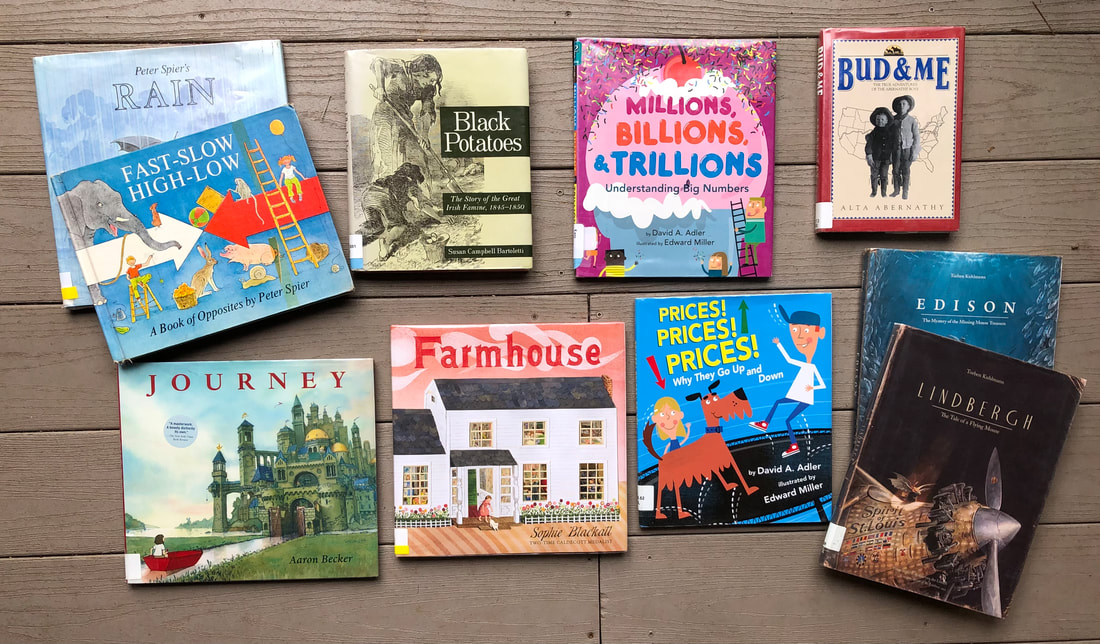
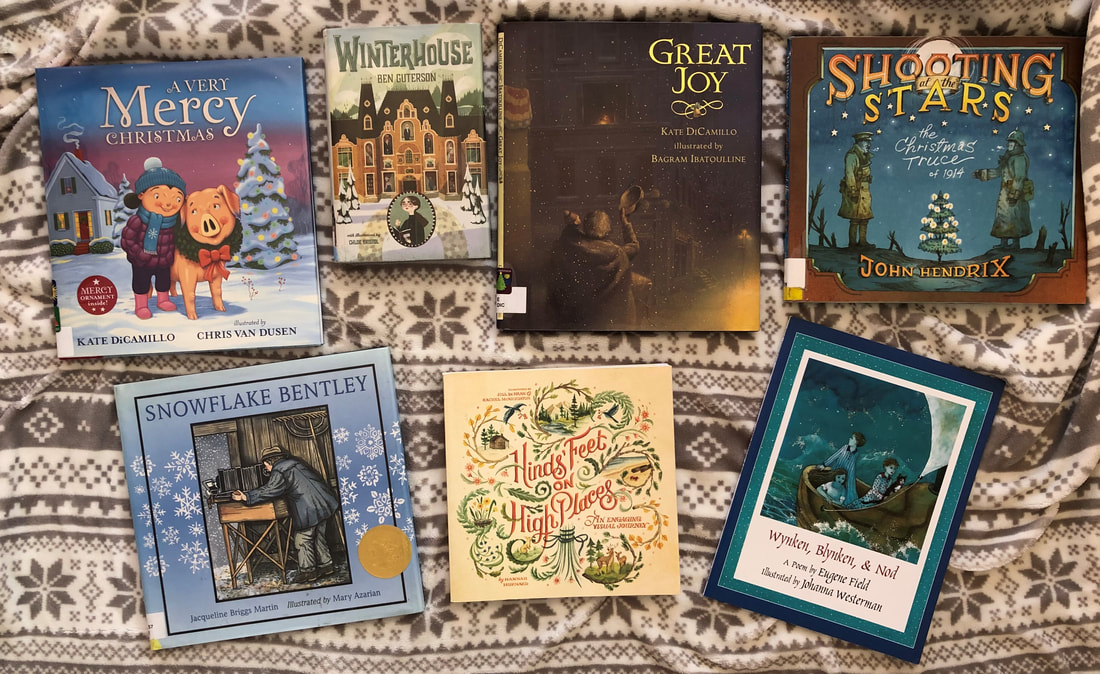
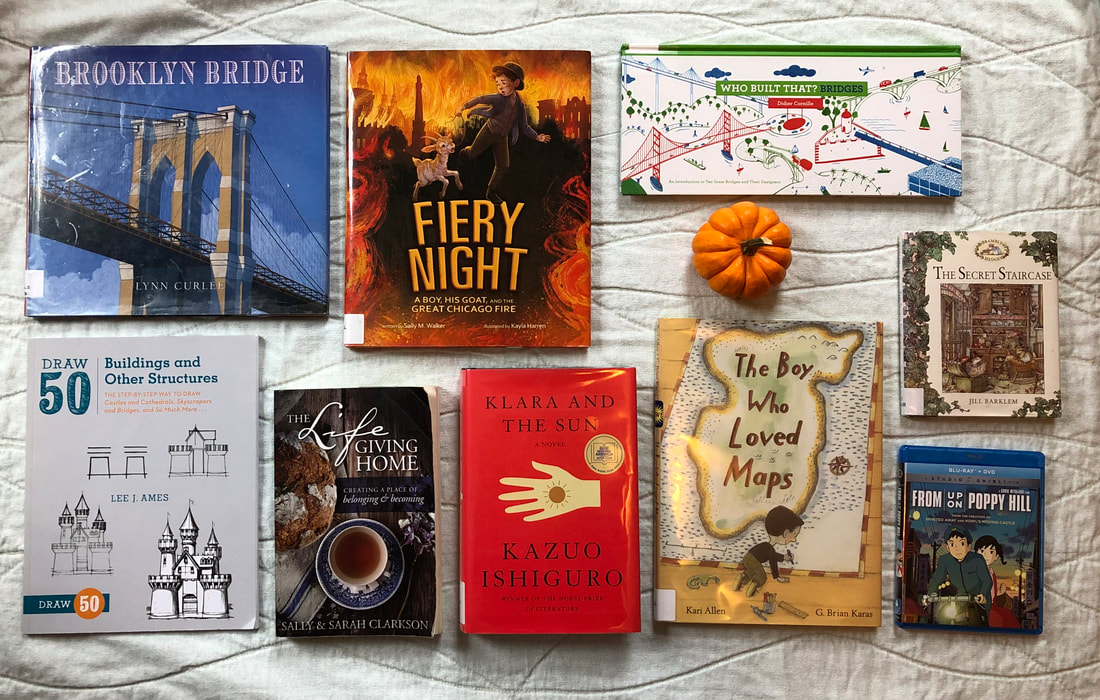
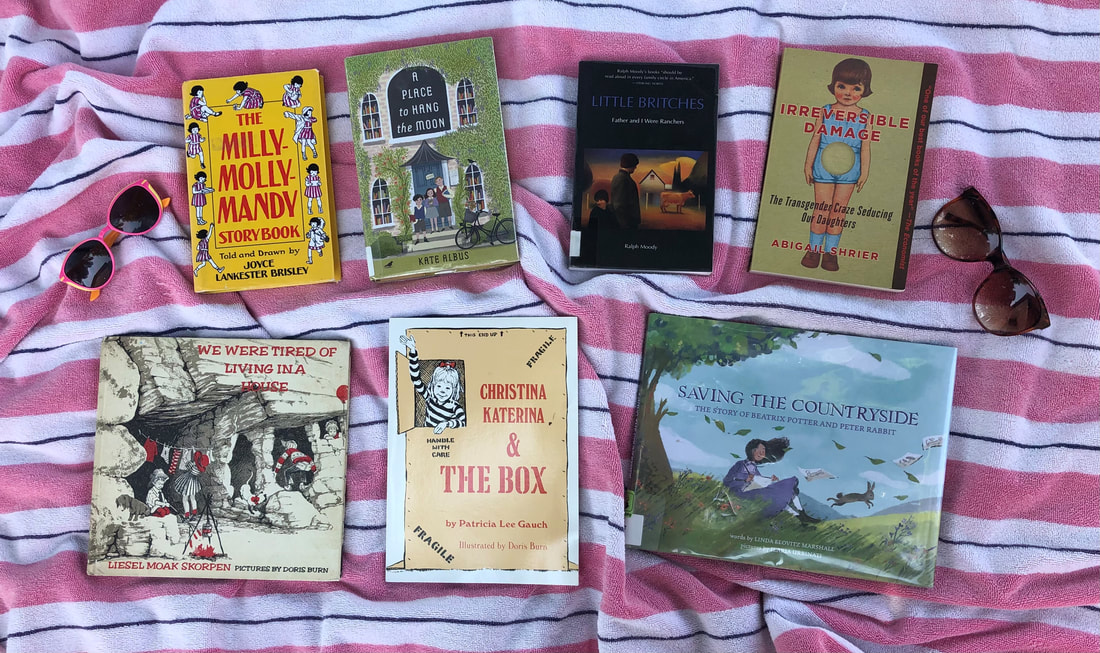

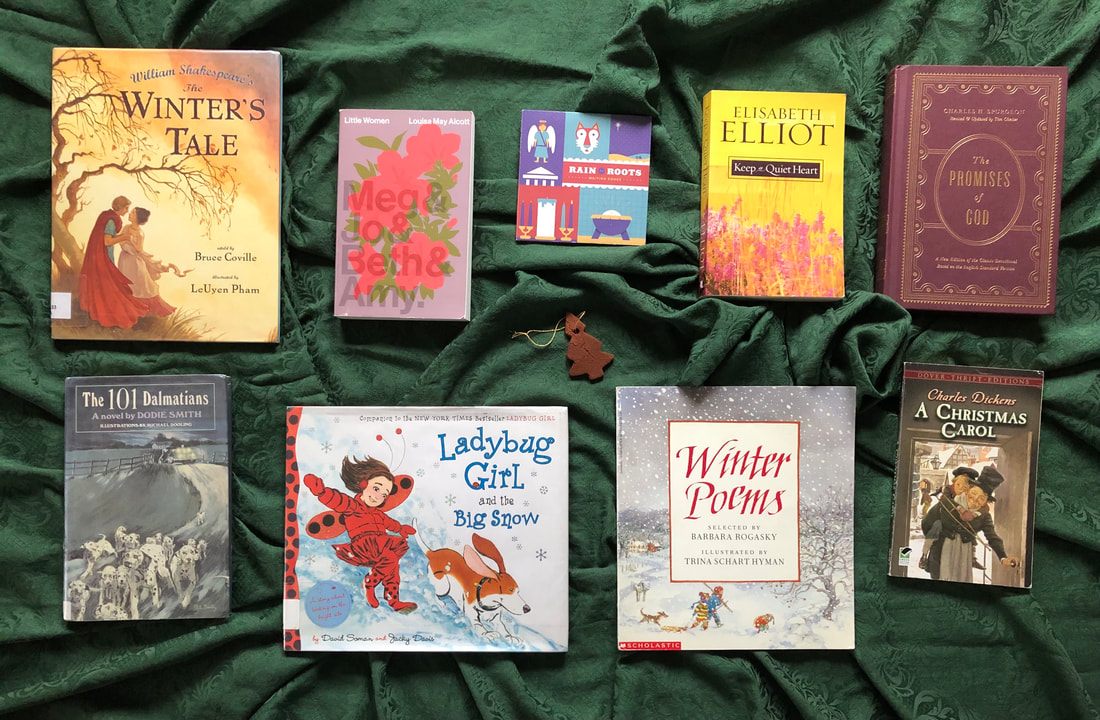
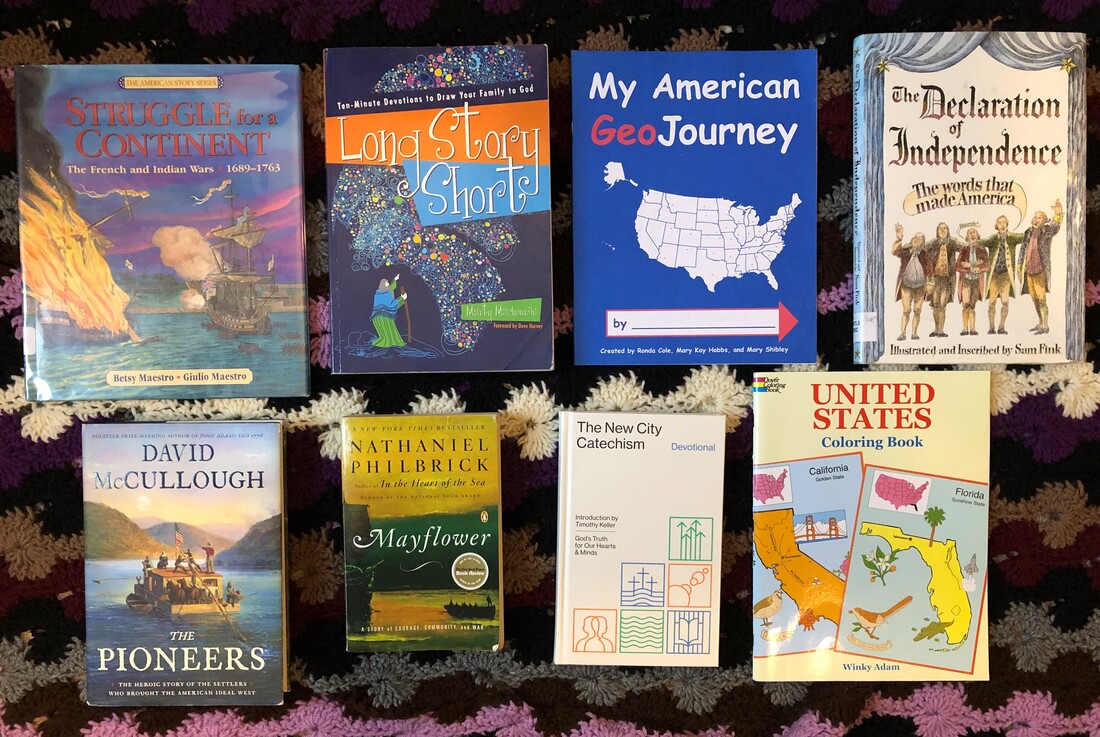
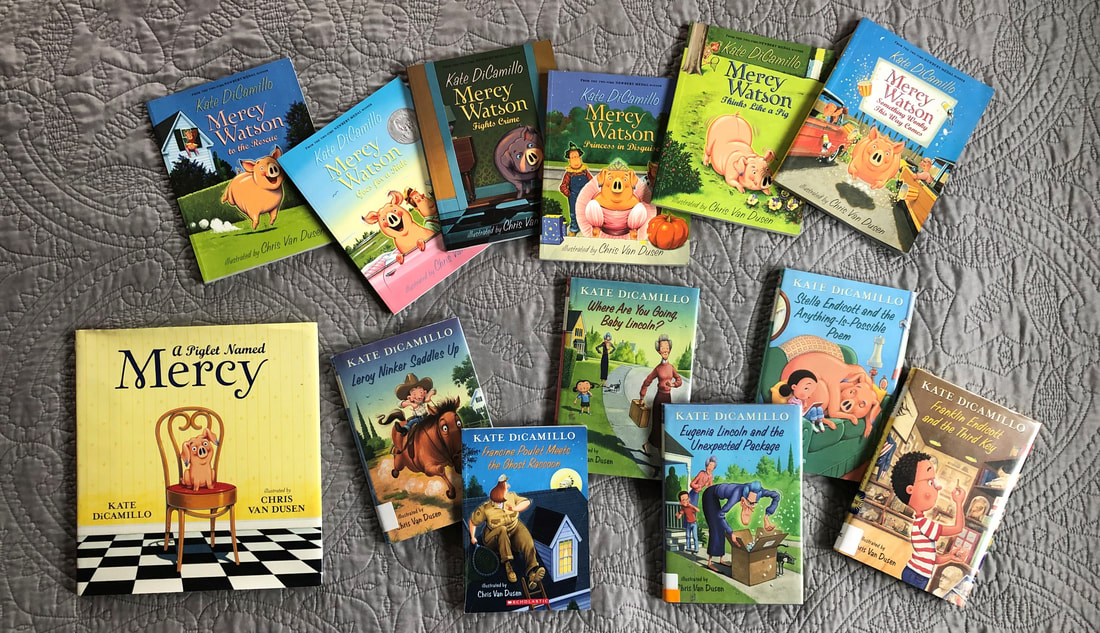
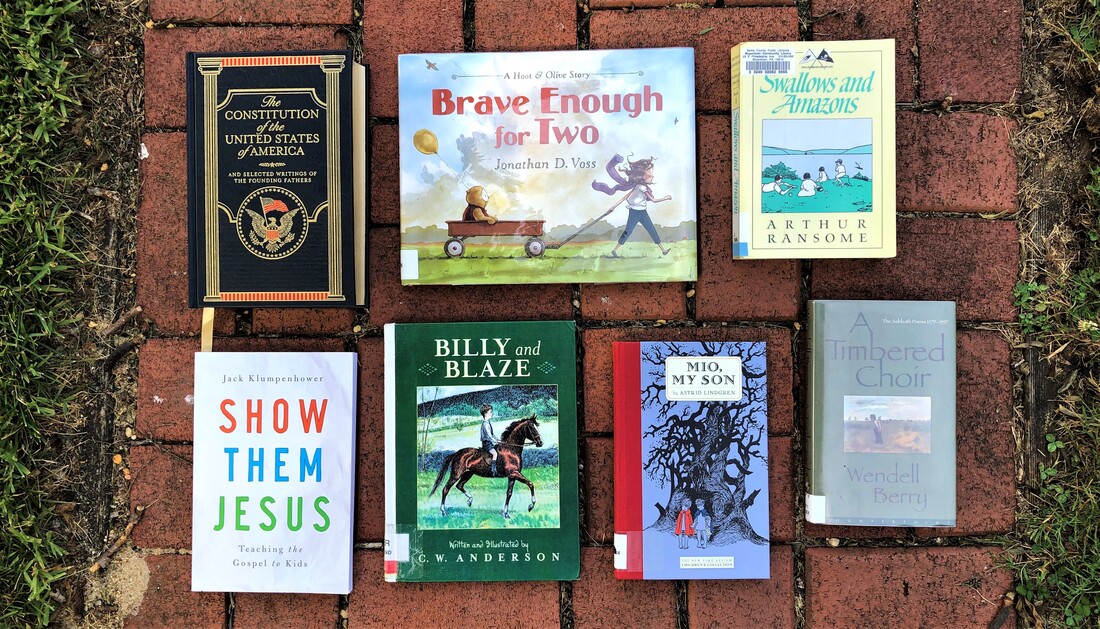
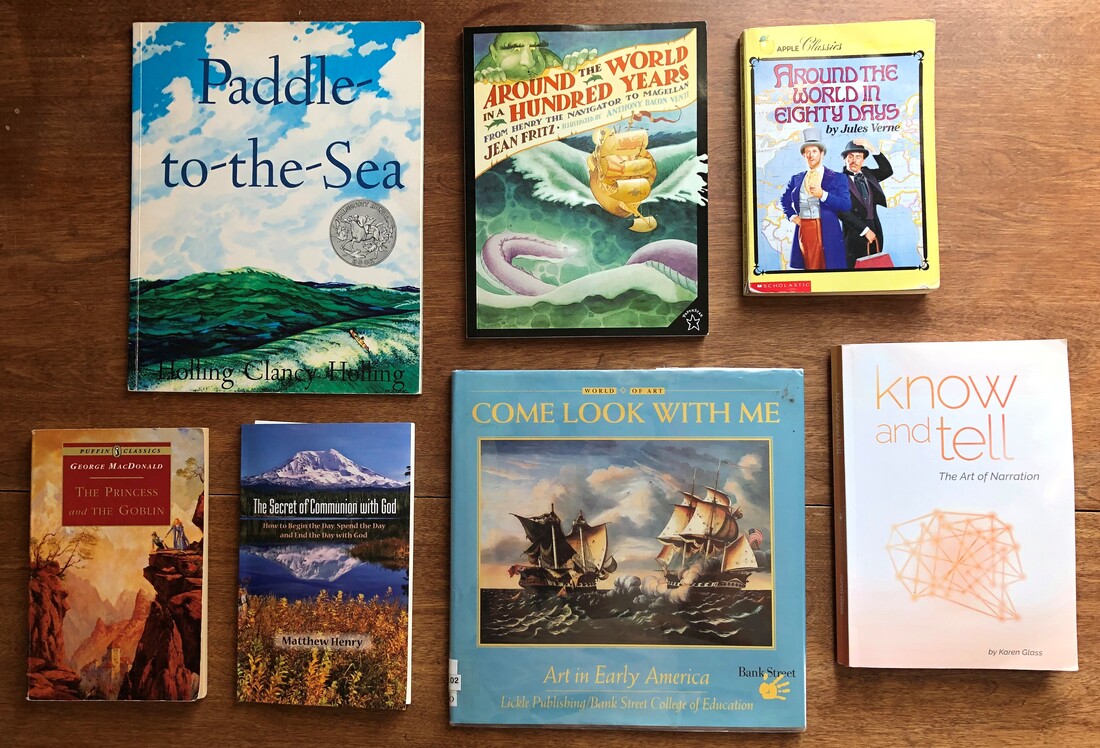
 RSS Feed
RSS Feed